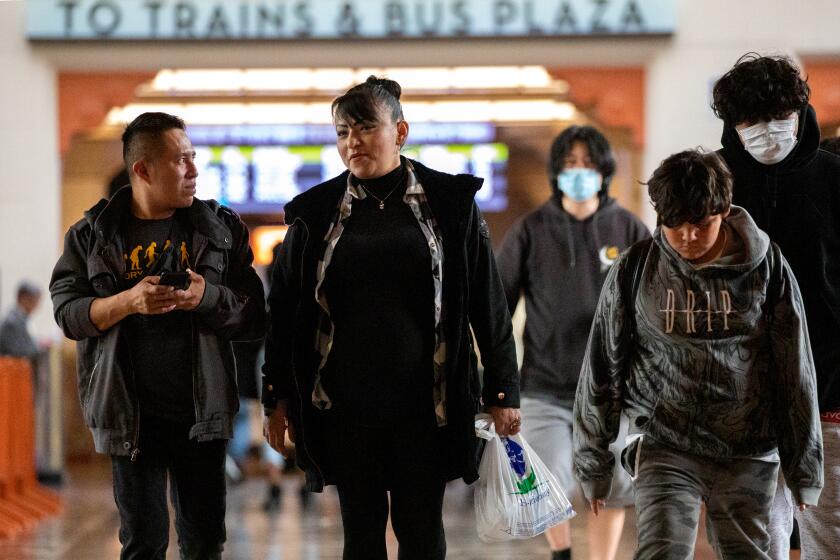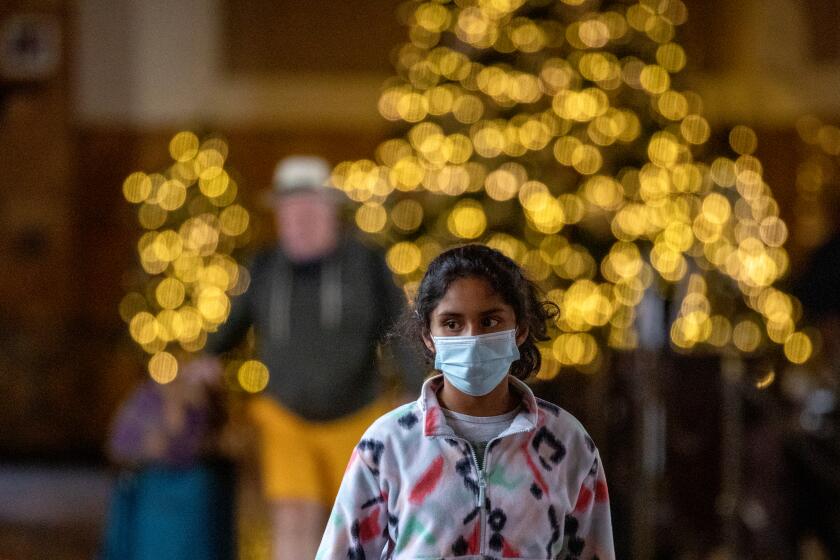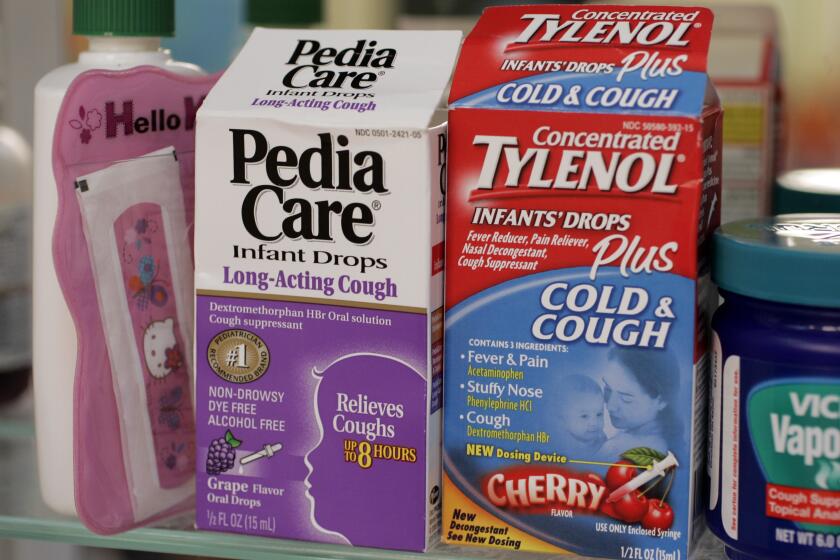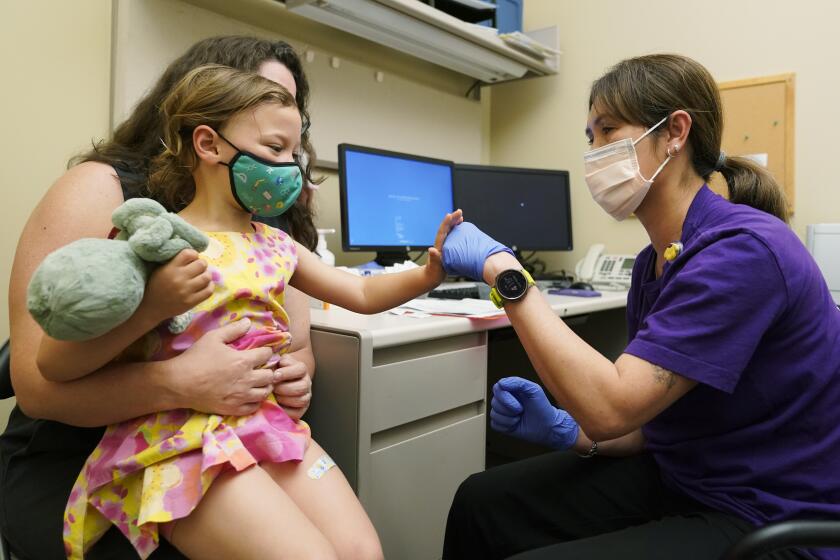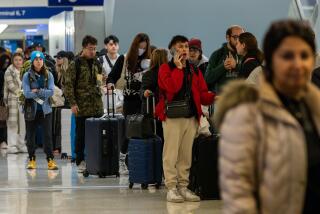COVID-19 cases are starting to drop in L.A. Will the decline last?
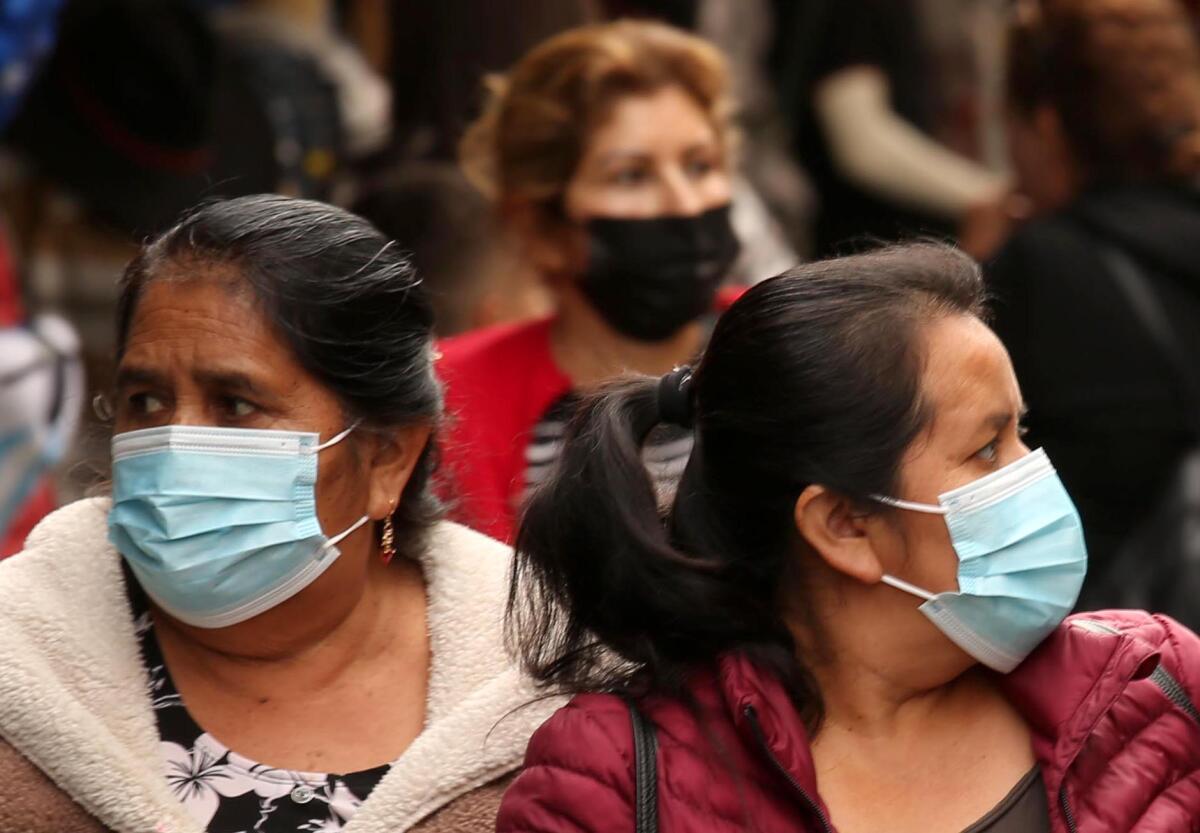
- Share via
The number of newly reported COVID-19 cases has ticked down in Los Angeles County, a reprieve following weeks of increases.
Whatever the wider prognosis for the winter, this dip will almost surely delay the return of a public indoor mask mandate in the nation’s most populous county.
For the week to Tuesday, L.A. County’s case rate was 3,148 a day, down 18% from last week. On a per capita basis, that’s 218 cases a week for every 100,000 residents. A rate of 100 or more is considered high.
Many experts caution that official case figures, while a useful metric, are likely a significant undercount due to the proliferation of at-home tests, which are not reliably reported to public health agencies.
“Almost three years into the pandemic, there could be a sense of resignation with the ebbs and flow of transmission,” L.A. County Public Health Director Barbara Ferrer said during a recent briefing. “We’ve seen that even during the worst of surges, cases will start to come down after a few weeks. It would be dangerous, however, for us to feel that we no longer need to try to minimize the impact of these surges by taking some practical steps that can reduce transmission and illness severity.”
The drop in case numbers is more meaningful when accompanied by a slowdown of coronavirus-positive hospitalizations. For the week to Monday, there were 1,359 new coronavirus-positive hospital admissions across L.A. County, down 9% from a seasonal peak of 1,481 for the week to Dec. 2.
It’s not a given that the declines will continue. During the second Omicron wave last spring and summer, there were several brief downturns in the case rate and subsequent increases before the peak in late July.
With holiday travel and festivities still on tap, conditions could be ripe for an uptick in transmission.
Though it’s not required, L.A. County strongly recommends masking in indoor public settings, as do officials with the California Department of Public Health and the Centers for Disease Control and Prevention.
L.A. County is the only part of California that has publicly committed to instituting a public indoor mask mandate should pandemic conditions worsen to the point that COVID-19 is exerting sustained pressure on hospitals.
Local health officials are again strongly recommending that everyone wear a mask in indoor public spaces, but a mandate is looking more iffy.
Specifically, the weekly rate of new coronavirus-positive hospital admissions would have to be at least 10 per 100,000 residents, and at least 10% of staffed inpatient hospital beds would need to filled with such patients for two consecutive weeks. The criteria were determined by the county Public Health Department based on guidelines from the U.S. Centers for Disease Control and Prevention.
L.A. County has already hit the first threshold, and before the recent stabilization appeared on track to reach the second in late December. But the latest numbers extend that timeline, and officials last week expressed cautious optimism that a masking order can be avoided.
Even with the downturn, COVID-19 transmission remains high. L.A. County’s weekly case rate last week reached a seasonal high of 272 for every 100,000 residents. Even at a lower rate — around 260 — a gathering of 200 people would have an 80%-90% chance of including at least one infected person.
That’s why it remains important to take precautions, experts say. Staying home when sick, taking rapid tests before large events and restricting gatherings to outdoors can help.
The coronavirus and the flu are surging in California. Here are the steps to protect yourself from getting sick during the holiday season.
Additionally, it’s important to stay up to date on COVID-19 vaccinations, including the updated bivalent booster, experts say.
“We are not asking people to curtail their activities, to avoid activities or to shut down any activities,” Ferrer told reporters last week. “We’re letting people know that the risk is higher with elevated transmission. And because this is having an impact on our healthcare system and our vulnerable residents, it’s time to layer in sensible protections.”
Because of the prior uptick in cases and hospitalizations in L.A. County, COVID-19 deaths are increasing. The county reported 103 deaths for the week that ended Tuesday, up 34% from the prior week and the first time the rate has exceeded 100 since the summer.
The summer peak was 122 deaths for the week that ended Aug. 6.
In addition to COVID-19, L.A. County is grappling with high levels of influenza.
The emergency room at Children’s Hospital Los Angeles, where the flu positivity rate is 18%, remains so stressed that it cannot always accommodate transfers from other facilities.
With respiratory diseases circulating widely in L.A. County, officials are urging residents to use a familiar tool to help thwart transmission: masks.
The cumulative flu hospitalization rate is higher for this time of the season than it has been for the last dozen years, according to the CDC.
“Influenza is ramping up quite dramatically,” affecting both adults and children, Dr. Charles Bailey, medical director for infection prevention at Orange County’s Providence St. Joseph Hospital and Providence Mission Hospital, said in an interview Friday.
The rise in flu cases has mainly affected Providence’s emergency rooms because most people who come in with symptoms are not admitted, Bailey said.
Some California hospitals have had to set up tents outdoors to handle the increased demand, including Huntington Hospital in Pasadena, UC San Francisco Benioff Children’s Hospital in San Francisco and facilities in San Diego County. Pomona Valley Hospital Medical Center recently hit a record high number of patients at its emergency department in a single day.
California is simultaneously contending with a spike in coronavirus transmission, an early onslaught of RSV and a strong start to the flu season.
Children’s hospitals in Orange County have been so stressed with viral illnesses that the health officer has declared a health emergency, with officials saying the numbers in their emergency departments are at unprecedented levels, forcing playrooms to be converted into patient care areas.
In Fresno County, some emergency rooms “are close to disaster levels,” with hospitals working over capacity, the local health department has said.
Dr. Nancy Gin, regional medical director of quality and clinical analysis at Kaiser Permanente Southern California, said Friday that cases of respiratory syncytial virus among young children seem to have crested in the previous weeks. However, she said, “what we’re seeing is now people are having co-infections with flu and COVID” or other viral combinations.
Flu and RSV this year descended much earlier than usual, so “even without having COVID numbers shooting out the roof, as we did last year with Omicron, we are experiencing a constellation of illness for the community,” Gin said. “And that’s what’s different.”
With COVID-19, flu and RSV cases rising, drugmakers and retailers say soaring demand is leading to empty shelves.
At Cedars-Sinai Medical Center in Los Angeles, “we are definitely very, very busy, for sure, but managing at this point,” said Dr. Jeffrey A. Smith, executive vice president of hospital operations.
Smith said Friday that “the entire hospital is full” but estimated that COVID, RSV and the flu represent 13% of patients. Among COVID patients, “very few are in our intensive care units,” he said, adding that other patients may be catching up on medical care they delayed earlier in the pandemic.
U.S. regulators have cleared pediatric doses of the updated COVID-19 vaccines to children ages 6 months to 5 years.
Cedars-Sinai has recruited more staff and expanded areas to care for patients, including curtaining off places in the hospital as “alternative care units.” It has avoided delaying or canceling surgeries, Smith said.
As a highly specialized hospital, “we really don’t have truly elective surgeries,” he said. “These patients are either in pain or at risk of further decline if we delay their surgeries.”
Bailey of Providence said one wrinkle is that the flu treatment Tamiflu is in limited supply, prompting the facility to come up with guidelines on who should get it. But “in most cases, the supportive care is as important as the medication,” he said, and often “Tamiflu is not a necessity for that to resolve.”
“Hopefully, any steep rise with COVID will politely wait its turn until after the flu has peaked,” he added.
More to Read
Sign up for Essential California
The most important California stories and recommendations in your inbox every morning.
You may occasionally receive promotional content from the Los Angeles Times.

